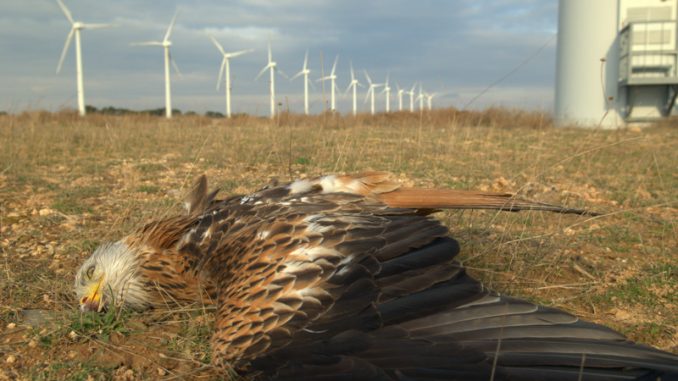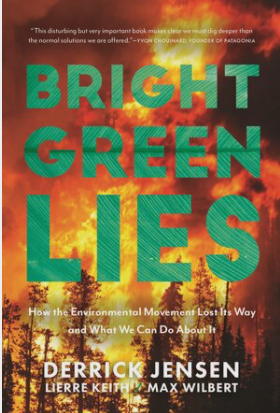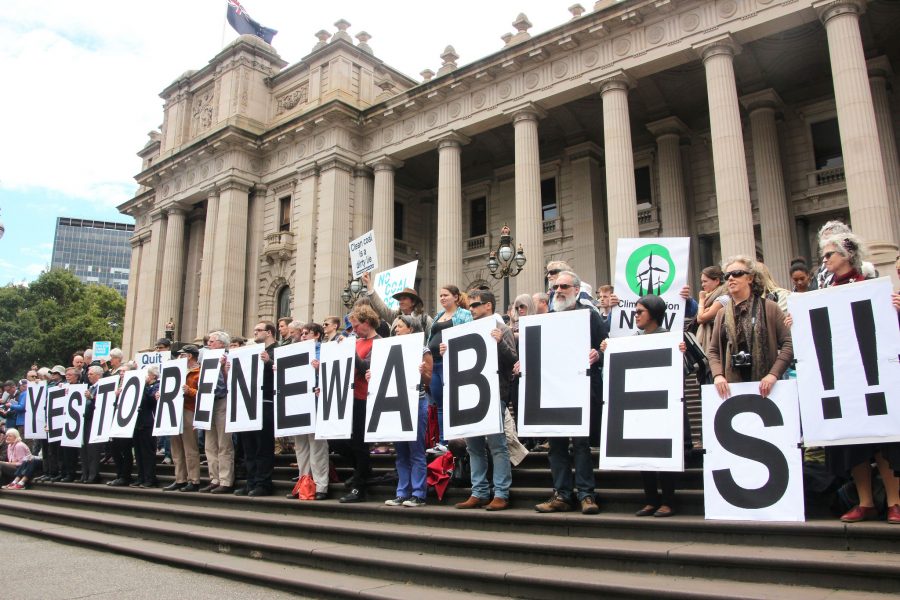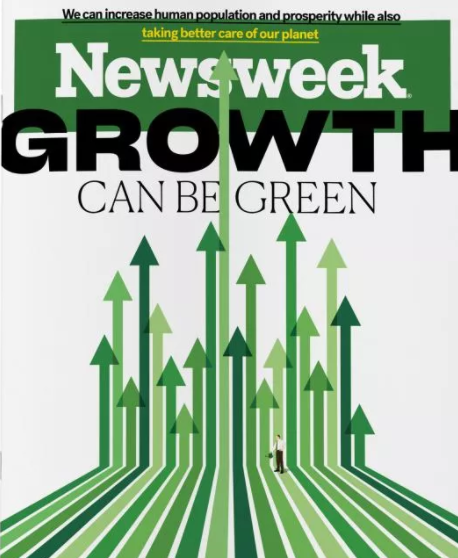
To discern ugliness requires a sense of beauty. To name darkness involves knowing light. And to correctly identify lies demands a grasp of truth.
It makes sense, therefore, that behind the title of the newly-published Bright Green Lies, by Derrick Jensen, Lierre Keith and Max Wilbert, (1) we find three important and sombre truths.
The first of these is that industrial society is killing the living planet.
Jensen’s magnificent 2006 work Endgame helped me enormously in finding the confidence to see and state this truth as an objective fact.
Previously, I had tended to regard it rather as a subjective opinion of mine, born of my personal aesthetic and moral distaste for the infrastructure and ideology of this ugly and empty modern world.
The same Endgame clarity shines through the almost-500 excellent pages of Bright Green Lies.
“The industrial economy is based on systematic theft from land bases, and the conversion of these living communities into dead products. That’s what an industrial economy is. The economy does not create value for the real world: It destroys the real world”, (2) insist the authors.
 Development is “a euphemism for destruction”, (3) they point out. “There can be no such thing as a ‘green superpower’, a ‘green industrial system’, or a ‘nonextractive industrial system’. These are all oxymorons”. (4)
Development is “a euphemism for destruction”, (3) they point out. “There can be no such thing as a ‘green superpower’, a ‘green industrial system’, or a ‘nonextractive industrial system’. These are all oxymorons”. (4)
They set out to challenge “the unstated acceptance that industrial levels of consumption cannot be questioned, never mind curtailed”. (5)
“We need to stop being guided by the general story that we can have it all, that we can have our industrial culture and also have wild nature, that we can have an oil economy and still have polar bears”, (6) writes Jensen.
Wishful thinking lies at the heart of the general blindness regarding the severity of the problem. People simply don’t want to believe that things are really that bad, that they might really have to leave behind the plastic security of the industrial womb and face raw and natural reality.
As consumers we have been conditioned not to think too much about where anything comes from and how it is made. Guilt is not good for sales.
Bright Green Lies reminds us: “Things don’t magically appear because it’s convenient for you to think they do. Things come from somewhere. These things require materials. There are costs associated with extracting these materials. These costs are paid by someone. Even if you want a groovy, solar-powered mass transit system, the materials still have to come from somewhere someone else lived until their home was destroyed so you can have what you want”. (7)
They know that their message is not one that most people want to hear.
 “We get it. We, too, like hot showers and freezing cold ice cream, and we like them 24/7. We like music at the touch of a button or, now, a verbal command. We like the conveniences this way of life brings us. And it’s more than conveniences. We know that. We three co-authors would be dead without modern medicine. But we all recognise that there is a terrible trade-off for all this: life on the planet. And no individual’s conveniences – or, indeed, life – is worth that price”. (8)
“We get it. We, too, like hot showers and freezing cold ice cream, and we like them 24/7. We like music at the touch of a button or, now, a verbal command. We like the conveniences this way of life brings us. And it’s more than conveniences. We know that. We three co-authors would be dead without modern medicine. But we all recognise that there is a terrible trade-off for all this: life on the planet. And no individual’s conveniences – or, indeed, life – is worth that price”. (8)
The picture could not be painted any clearer than in the statement made towards the end of the book: “Industrial civilization is incompatible with life on the planet”. (9)
The second truth exposed, one particularly hard for many contemporary environmentalists to face up to, is that “renewables” are a scam.
“We are being sold a story, and we are buying it because we like it,” say the authors. “We want it to be true. We want to believe that our lives can go on with all the ease and comfort we accept as our due. How painless to believe that a simple switch of wind for oil and solar for coal and we can go on with our air conditioning and cell phones and suburbs. Every time we hit a trip wire of unsettling facts or basic math, we soothe ourselves with our faith in technology”. (10)
They marshal a massively impressive, detailed and fully-referenced body of evidence to demonstrate, beyond the slightest doubt, that these bright green “solutions” are not only toxic and destructive to nature, but are not even capable of performing the role they are billed as performing.
“The brutal truth is that oil is fundamentally irreplaceable for an industrial economy”, (11) the authors note. “It is remarkably dishonest to pretend that ‘renewables’ meeting 74 or 78 percent of electricity on a sunny, windy, weekend afternoon even remotely implies that ‘renewable sources can power a large industrial nation'”. (12)
This means, they explain, that the idea of “green energy”, which social consensus tells us is a sound one, is not in fact sound at all – “neither in the broad strokes (continuing to fuel the destruction of the planet is in fact a bad idea) nor in the particulars (that nondestructive sources of industrial scale energy exist)”. (13) They add: “Again and again, the policies and technologies promoted by bright greens do the opposite of their purported goal”. (14)
 Given all the long-available evidence supporting this analysis, it is strange that there is not more outrage about the deceit involved.
Given all the long-available evidence supporting this analysis, it is strange that there is not more outrage about the deceit involved.
“Why aren’t more people screaming at the absurdity of these bright green fantasies?” (15) ask Jensen, Keith and Wilbert. “You have an entire culture killing the planet and calling this destruction ‘saving the earth'”. (16)
Their aim is to wake people up to the scam and to provide them with the analytic framework and “tools” to debunk such claims on their own. (17)
One of the main elephants in the renewables room is the fact that the materials for its infrastructure need to be extracted from the earth: “When bright greens tell you that it’s possible to have something resembling this way of life without mining, they’re not telling the truth”. (18)
 Another is that the products of the new “green” economy are transported all around the world in ships and “the 16 largest ships create more pollution than all the cars in the world”. (19)
Another is that the products of the new “green” economy are transported all around the world in ships and “the 16 largest ships create more pollution than all the cars in the world”. (19)
Further flies in the eco-ointment include:
SOLAR. “Industrial solar energy doesn’t help the world. It’s just another way to power industrial capitalism. At root, it’s an industrial product designed and built in the global capitalist marketplace to make a profit. Like other products, it leaves behind the wreckage of destroyed land, poisoned water, and devastated communities”. (20)
WIND TURBINES. “In December 2013, the federal [US] government exempted the wind industry from federal protections of bald and golden eagles. For the next 30 years, wind turbines can legally kill federally protected bald and golden eagles with no penalty. Remember, this is a technology promoted by the modern environmental movement”. (21)
BIOFUELS. “Just a fancy word that means burning living materials like wood – and what you and I might call ‘planting monocrops to use as fuel’ or ‘cutting down forests to burn'”. (22)
GREEN CARS. “Cars themselves harm the earth, whether they’re made of steel, carbon fiber, or ‘eco-plastics’; and whether they’re powered by gasoline, diesel, solar energy, or refined methane captured from unicorn farts”. (23)
WATER-POWERED FUEL CELLS. “One estimate looked at private passenger vehicles in the US and found that producing enough hydrogen for their operation would take 160 million gallons of purified water per day. Running all the private passenger vehicles in the US on water-powered fuel cells would be, in terms of water consumption, like adding four new cities the size of Los Angeles”. (24)
GREEN CITIES. “Green cities remain not just elusive but physically impossible. In fact, cities around the world function essentially the same as they have for thousands of years, as centers of consumption, control and power. Modern cities are not just linked to the destruction of the planet; they’re central to it”. (25) “Conserving nearby land doesn’t mean much when your economy is killing the planet elsewhere”. (26)
GREEN POWER GRID. “The new grid looks a lot like the old grid. It delivers electricity to factories and subdivisions (and now, cars). The power it delivers was generated in processes that are destroying the planet. The grid itself is destroying the planet, in its production, installation, operation, and maintenance. Instead of campaigning for more grids, we should be fighting them, indeed removing them”. (27)
GEOENGINEERING. “Spraying aerosols from planes is only one of the lunatic ideas put forward under the name of geoengineering. Also floated are ideas like putting mirrors in space to deflect sunlight, or somehow changing the earth’s orbit. Or dumping iron into the ocean to promote blooms of phytoplankton. What could go wrong?” (28)

REYCYLING. “The process of recycling materials itself requires an infrastructure that is harmful to both the environment and humanity. Not only does the recycling process very often cause more waste and pollution, but it frequently relies upon nearby populations living in unsafe conditions and workers being subjected to both toxins and slave labor”. (29)
E-WASTE. “Electric cars (along with nearly all the other green technologies, especially solar panels), also contain electronics, circuit boards, and other computer components. When this material is thrown away, it’s known as e-waste”. Recycling e-waste is “one of the most hazardous known industries”, the authors note, quoting an impact assessment report that describes e-waste as “a serious environmental and human health threat”. (30)
The authors describe their reference to bright green sell-out Naomi Klein’s infamous statement in the film This Changes Everything that polar bears “don’t do it for me” (31) as “the single most important passage in this book” (32) illustrating as it does so perfectly the degraded state of contemporary environmentalism, shorn of the deep and instinctive love of nature which once fed its soul.
Instead, this brave new pseudo-environmentalism appears to be all about money, in a general and more specific sense.
The book refers to researcher Cory Morningstar and her Wrong Kind of Green blog (33) and echoes her analysis that ultimately the bright green “climate” movement is not about saving the planet but about saving capitalism, that it is “a desperate attempt to stave off facing the consequences of our way of life, even though it will lead to an even more horrifying collapse at the end”. (34)
 “Most environmentalists assume we must maintain the high-energy modern lifestyle; we must at all costs avoid disturbing the ‘prosperity’ so important to bright greens”, (35) they add.
“Most environmentalists assume we must maintain the high-energy modern lifestyle; we must at all costs avoid disturbing the ‘prosperity’ so important to bright greens”, (35) they add.
For fake greens, “the ongoing destruction of the planet, and the continued dominance of coal, oil, and gas; seems to be less important than diverting people’s rage – which, if left unchecked, might actually explode into something that would stop capitalism and industrialism from murdering the planet – into corporate-friendly ends”. (36)
As well as wanting to prevent the collapse of the money system off which they feed, climate capitalists are out to make a considerable personal profit from the bright green technology bubble, at the expense of public funds mobilised to address the climate emergency.
The authors comment: “If you ask many of the people who march for the environment why they’re mobilizing, they’ll tell you they’re trying to save the planet; but if you ask for their demands, they often respond that they want additional subsidies for solar manufacturers… one could easily be forgiven for concluding that much environmentalism has become a de facto lobbying arm of the solar industry”. (37)
“And that, really, is what the bright green movement is about. Capturing subsidies for specific sectors of the industrial economy. To the dedicated young people marching to save the planet, we offer our solidarity. But the demands of this movement boil down to public money for sectors of the industrial economy”. (38)
“It’s pretty clear that the real goal of the bright greens isn’t defending the planet… The real goal is to get money into so-called green technology”. (39)
 As Jensen notes in his Afterword, this is particularly true of the various “deals” for nature currently being touted by fake-green capitalists: “The Green New Deal, which is being pushed so hard by mainstream environmentalists, has far less to do with saving wild places and wild beings than it does with generating subsidies for favored sections of the industrial economy, with estimates of the giveaways running from hundreds of billions to trillions of dollars”. (40)
As Jensen notes in his Afterword, this is particularly true of the various “deals” for nature currently being touted by fake-green capitalists: “The Green New Deal, which is being pushed so hard by mainstream environmentalists, has far less to do with saving wild places and wild beings than it does with generating subsidies for favored sections of the industrial economy, with estimates of the giveaways running from hundreds of billions to trillions of dollars”. (40)
Genuine solutions to the environmental crisis, such as deconstructing the industrial economy, will never be considered, the book observes, because genuine environmentalism “doesn’t serve the industrial agenda (or the desires of the financial elites)”. (41)
Economic growth, the enemy of real natural growth, remains the holy cow of an ideology belonging entirely to the industrial capitalist system.
“Nearly all bright greens speak of economic growth as positive, or at the very least don’t speak against it”, remark Jensen et al. “Given that the global economy is killing the planet, ‘growing the economy’ will not help the planet”. (42)
The third sombre truth revealed by this book is that the “renewables” and “climate justice” bandwagon, for all its holier-than-thou posturing, is in fact carrying us faster towards the death of the planetary organism.
With their distraction of unworkable and unhelpful phoney “solutions”, they are preventing us from reacting as we should to this existential crisis.
The fossil fuels industry may have set our house on fire, as Greta Thunberg likes to suggest, but she and the climate capitalists who back her are trying to herd us towards a false escape route, through a door leading deeper into the deadly industrial inferno rather than away from it.
“Bright green environmentalism does great harm by wasting time we don’t have on ‘solutions’ that cannot work”, (43) say the authors.
 It has also (temporarily) scuppered authentic resistance by taking over eco-activism, neutering its threat to the industrial and financial ruling clique and turning it into a tool for advancing their interests.
It has also (temporarily) scuppered authentic resistance by taking over eco-activism, neutering its threat to the industrial and financial ruling clique and turning it into a tool for advancing their interests.
“Something has gone terribly wrong with the environmental movement”, writes Lierre Keith in her Prologue (44) and she and her colleagues repeat the message throughout the book.
“Mainstream environmentalists now overwhelmingly prioritize saving industrial civilization over saving life on the planet”. (45) “This has become a movement that does not help the earth, but rather helps its destroyers”. (46) “We are writing this book because we want our environmental movement back”. (47)
These three sombre truths – that industrial society is destroying all life, that renewables are a scam and that fake greens are in fact advancing the death of the planet – are difficult enough to come to terms with.
But no broader assessment of where we are today would be complete without reference to the techno-fascist New Normal being rolled out on the back of the “Covid crisis”.
So there is a fourth sombre truth on the table here, as set out in this brief article. The illusion of democracy has been abandoned and the ruling 0.1% are lining up a future of slavery for our children and grandchildren.
A fifth sombre truth is that the people and networks behind this tyranny are very much the same as those promoting the climate capitalist scam!
 For the last few years there has been a page of links on the Winter Oak website called Climate Capitalists. In 2020, another page of links was created under the heading The Great Reset. It has subsequently become increasingly evident that these might as well be one and the same page.
For the last few years there has been a page of links on the Winter Oak website called Climate Capitalists. In 2020, another page of links was created under the heading The Great Reset. It has subsequently become increasingly evident that these might as well be one and the same page.
This is not the subject of Jensen, Keith and Wilbert’s book but the “bright green future” they describe is instantly recognisable as that of the Fourth Industrial Revolution, aka The Great Fascist Reset.
They write: “The bright green future is a corporate future, a centralized future, a robotic, mechanized future emerging from factories like new LED bulbs in plastic blister cases. What appears to be a simple lightbulb – flick the switch and it turns on – is the result of a long chain of industrial technologies and processes involving mining, factories, complex chemistry, robotics, research laboratories at corporate and government facilities around the world, and billions of dollars of investment. It’s all tied together. LEDs would be impossible to create without globalization, imperialism, resource theft, and war”. (48)
And they clearly identify “Technocrats/Transhumanists” as being, of course, at the other end of the political spectrum to their own deep green position, explaining that, for these worshippers of artifice and technology, “humans should transcend biology by investing heavily in technology. We can also avoid the possibility of human extinction by leaving planet Earth behind, and we should ultimately move toward cybernetic enhancement and uploading human consciousness into machines in order to defeat death”. (49)
Transhumanists are vitaphobic. They hate life and want to replace everything alive with the dead matter that occupies the place where their own hearts should be.

So-called environmentalists who align themselves with transhumanist goals are doing the exact opposite of what they once did.
As Keith puts it: “Once we fought for the living. Now we are told to fight for their deaths, as the wind turbines come for the mountains and solar panels conquer the deserts”. (50)
The same could be said of anarchists and other leftists who once fought for the people and their freedom and now fight for their enslavement in a digital prison built from impact intersectionality and its dogma of conformity, separation and artifice.
Social movements, like the green movement, have been taken over by the technocrat system and pointed in directions which serve, rather than oppose, their insidious agendas.
These corporate-controlled pseudo-activists use the language of the system, endlessly regurgitating its duplicitous talk of “equity”, “social change”, “inclusivity” and, of course, “sustainability”.
They are also trapped within its syntax (as Guy Debord put it), being unwilling or unable to think beyond the assumptions on which the system is founded.
 Anyone who dares to do so is immediately accused, and automatically found guilty, of heresy, of Orwellian thoughtcrime, today packaged as some variety of “denialism” or “hate speech”.
Anyone who dares to do so is immediately accused, and automatically found guilty, of heresy, of Orwellian thoughtcrime, today packaged as some variety of “denialism” or “hate speech”.
Their term “conspiracy theorist” is used to try to stop us identifying the existence of a very real system out there, with a life-hating and freedom-hating programme consisting of many different aspects and using all sorts of excuses (“terrorists!” “climate crisis!” “pandemic!”) to lure us ever deeper into its total control.
There is no point at all in seeing through the lies of the renewables scam if you are still going to be corralled into supporting a transhumanist totalitarian future by means of your gullibility with regard to the Covid manoeuvre.
There is no point at all in seeing through the lies of the Covid manoeuvre if you are still going to be corralled into supporting a transhumanist totalitarian future by means of your gullibility with regard to the renewables scam, or indeed by your refusal to face up to the fact that industrial society needs to be brought down if life is to go on living.
Jensen, Keith and Wilbert do not beat about the bush concerning the reality of what we are facing. They follow up their statement that “industrial civilization is incompatible with life on the planet”, which I quoted earlier, by remarking: “That makes the solution to our systematic planetary murder obvious, but let’s say it anyway: Stop industrial civilization”. (51)
“The most important, and simplest, solution to the destruction of the planet is to stop the destruction of the planet”, (52) they add. That sounds stupidly obvious, but so many people simply fail to get it.
Whenever real greens talk about ending industrial society, people always want to know what we imagine could replace it.
The answer is not difficult. We need to go back to living the way we did for hundreds of thousands of years before we started on the slippery slope to where we are now.
 This is not turning the clock back, but moving forward in a direction inspired by what we know was previously possible. We need to reclaim the revolutionary wisdom of the past.
This is not turning the clock back, but moving forward in a direction inspired by what we know was previously possible. We need to reclaim the revolutionary wisdom of the past.
It is not so much about politics as values, as the Bright Green Lies authors rightly note. (53) Humankind needs to go back to knowing itself part of nature and living accordingly.
Long before “sustainability” was an empty WEF marketing slogan, it was a physical reality.
Write Jensen et al: “How’s this for a measure of sustainability: If your way of life can last at least 3,800 years without trashing a place, that’s sustainable. On the other hand, if your culture – largely driven by your dense cities – has managed to destroy 98 percent of a continent’s old-growth forests within a few centuries, then your way of living is not sustainable”. (54)
“Economic growth must stop” (55) they say, and instead we need to build communities “based on self-sufficiency, biological integrity, and human rights”. (56)
If we are going to move towards this new reality, we are first going to have to pull apart the lies of the current one, as the authors of this book, which does just that, are evidently very aware: “The first step is to stop believing in bright green fairy tales that technology will save the planet. Instead, put your belief in soils, grasses, forests, seaweeds, and the billions of living beings who every moment are working to regenerate the conditions that support life and beauty on this planet”. (57)
But, of course, the system won’t dismantle itself, nor sit idly by while we embark upon doing so, and we necessarily face a huge struggle ahead, a struggle for life itself.
“We need to return to the real world,” write the authors. “We need to return to being people who love the world – all its places and all its creatures – and who will fight to defend it”. (58)
“We need massive movements to relentlessly impede the functioning of industrial civilization, using every tactic: political pressure, legal challenges, economic boycotts, civil disobedience, and whatever else becomes necessary”. (59)
They warn: “We have written this book because life has been broken and is now fast draining away through the cracks. The cultures that have done that breaking need to be abandoned and their ruling sociopaths dethroned. Make no mistake, this will require a serious and dedicated resistance movement”. (60)

1. Derrick Jensen, Lierre Keith, Max Wilbert, Bright Green Lies: How the Environmental Movement Lost Its Way and What We Can Do About It (New York: Monkfish, 2021). All subsequent page references are to this book.
2. p. 33.
3. p. 344.
4. p. 38.
5. p. 81.
6. p. xiv.
7. p. 313.
8. p. 27.
9. p. 433.
10. p. 177.
11. p. 158.
12. p. 71.
13. p. 151.
14. p. 205.
15. p. 192.
16. p. 187.
17. p. 402.
18. p. 275.
19. p. 316. See John Vidal, ‘Health risks of shipping pollution have been ‘underestimated‘, The Guardian, April 9, 2009.
20. p. 91.
21. pp. 137-38.
22. p. 45.
23. p. 342.
24. pp. 185-86.
25. p. 302.
26. p. 339.
27. p. 378.
28. p. 419.
29. p. xv.
30. p. 278.
31. p. 24.
32. p. 465.
33. p. 428.
34. p. 321.
35. p. 311.
36. p. 425.
37. p. 30.
38. p. 163.
39. pp. 428-29.
40. p. 469.
41. p. 72, footnote.
42. p. 236.
43. p. 256.
44. p. xvii.
45. p. 22.
46. p. 430.
47. p. 22.
48. p. 229.
49. p. xxii.
50. p. xix.
51. p. 433.
52. p. 440.
53. p. 465.
54. p. 310.
55. p. 446.
56. p. 459.
57. p.442.
58. p. 431.
59. p. 458.
60. p. 18.
Leave a Reply